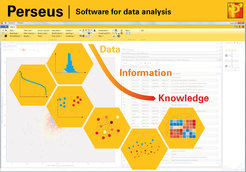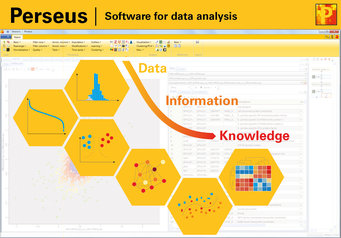Perseus translates proteomics data

Researchers in the life sciences can now use the free software platform www.perseus-framework.org to analyze raw data from high-throughput techniques.
Absolutely nothing in an organism works without proteins. These molecules operate as molecular machines, act as building materials and appear in a variety of other roles. However, they are rarely lone warriors, with the result that analyzing the sum total of all proteins in a cell, a tissue, a body fluid or even in an entire organism is essential. This can establish when and where a particular molecule appears in what quantity and with whom it interacts. Corresponding approaches exist for other biological molecules as well. Modern high-throughput techniques such as mass spectrometry provide the necessary raw data, often from several thousand different proteins.
Meaningful and relevant relationships need to be extracted and interpreted from these mountains of data. Given the huge quantity of raw data, this is now possible only with the help of computer-based methods. “These steps have become a bottleneck in high-throughput studies,” says Jürgen Cox, head of the research group ‘Computational Systems Biochemistry’ at the Max Planck Institute of Biochemistry, who leads the development of the Perseus platform. “We assume that there are still a lot of potentially important findings hidden in existing proteomics data only because the appropriate computer methods are technically too complex or the data does not end up with the researchers who could grasp the biological importance of the results.”
Cox and his team have therefore ensured that individual algorithms no longer have to find their way to the right laboratories. Instead, researchers can collect their software where they need it at a central point. Among other things, the Perseus platform allows highly varying protein amounts to be screened and analyzed. It can quantify proteins and capture their interactions and modifications. The platform incorporates statistical methods, which identify patterns, analyze time series data, test multiple hypotheses and compare data obtained from different techniques.
No previous knowledge or special training is required as the platform is an interactive environment involving user participation and featuring highly intuitive operability. The site features helpful descriptions of the functions and parameters, while YouTube videos explaining how to use the platform and a Google group with more than 1,400 active users also provide assistance. “Perseus successfully completed the first pilot tests, also in extremely complex interdisciplinary investigations,” as Cox relates. “In fact, the software not only runs on proteomic data, but also in other large data sets. In future, we will adapt the programs for metabolomic studies.”
Originalpublikation:
S. Tyanova, T. Temu, P. Sinitcyn, A. Carlson, M.Y. Hein, T. Geiger, M. Mann & J. Cox: The Perseus computational platform for comprehensive analysis of (prote)omics data, Nature Methods, June 2016
DOI: 10.1038/nmeth.3901







